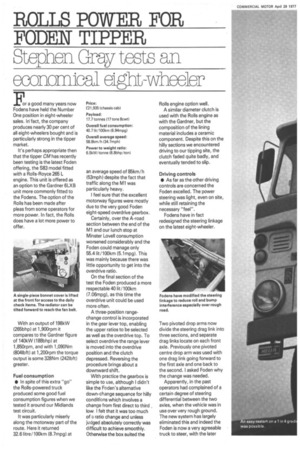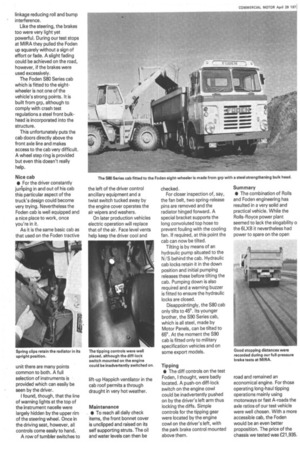ROLLS POWER FOR FODEN TIPPER
Page 76

Page 78

If you've noticed an error in this article please click here to report it so we can fix it.
Stepaen Gray tests an economical eigatrwneder
For a good many years now Fodens have held the Number One position in eight-wheeler sales. In fact, the company produces nearly 30 per cent of all eight-wheelers bought and is particularly strong in the tipper market.
It's perhaps appropriate then that the tipper CM has recently been testing is the latest Foden offering, the S83 model fitted with a Rolls-Royce 265 L engine. This unit is offered as an option to the Gardner 6LXB unit more commonly fitted to the Fodens. The option of the Rolls has been made after pleas from some operators for more power. In fact, the Rolls does have a lot more power to offer.
With an output of 198kW (265bhp) at 1,900rpm it compares to the Gardner figure of 140kW (188bhp) at 1,850rpm, and with 1,090Nm (8041bft) at 1,200rpm the torque output is some 328Nm (2421bft) greater.
Fuel consumption • In spite of this extra "go" the Rolls-powered truck produced some good fuel consumption figures when we tested it around our Midlands test circuit.
It was particularly miserly along the motorway part of the route. Here it returned 32.6 litre/100km (8.7mpg) at an average speed of 85km/h (53mph) despite the fact that traffic along the M1 was particularly heavy.
I feel sure that the excellent motorway figures were mostly due to the very good Foden eight-speed overdrive gearbox.
Certainly, over the A-road section between the end of the M1 and our lunch stop at Minster Lovell consumption worsened considerably and the Foden could manage only 55.4 lit/100km (5.1mpg). This was mainly because there was little opportunity to get into the overdrive ratio.
On the final section of the test the Foden produced a more respectable 40 lit/100km (7.06mpg), as this time the overdrive unit could be used more often.
A three-position rangechange control is incorporated in the gear lever top, enabling the upper ratios to be selected as well as the overdrive top. To select overdrive the range lever is moved into the overdrive position and the clutch depressed. Reversing the procedure brings about a downward shift.
With practice the gearbox is simple to use, although I didn't like the Foden's alternative down-change sequence for hilly conditions which involves a change from first direct to third , low I felt that it was too much of a ratio change and unless judged absolutely correctly was difficult to achieve smoothly. Otherwise the box suited the Rolls engine option well.
A similar diameter clutch is used with the Rolls engine as with the Gardner, but the composition of the lining material includes a ceramic component. Despite this on the hilly sections we encountered driving to our tipping site, the clutch faded quite badly, and eventually tended to slip.
Driving controls • As far as the other driving controls are concerned the Foden excelled. The power steering was light, even on site, while still retaining the necessary "feel".
Fodens have in fact redesigned the steering linkage on the latest eight-wheeler.
Two pivoted drop arms now divide the steering drag link into three sections, and separate drag links locate on each front axle. Previously one pivoted centre drop arm was used with one drag link going forward to the first axle and one back to the second. I asked Foden why the change was needed.
Apparently, in the past operators had complained of a certain degree of steering differential between the two axles, when the vehicle was in use over very rough ground. The new system has largely eliminated this and indeed the Foden is now a very agreeable truck to steer, with the later linkage reducing roll and bump interference.
Like the steering, the brakes too were very light yet powerful. During our test stops at MIRA they pulled the Foden up squarely without a sign of effort or fade. A slight fading could be achieved on the road, however, if the brakes were used excessively.
The Foden S80 Series cab which is fitted to the eightwheeler is not one of the vehicle's strong points. It is built from grp, although to comply with crash test regulations a steel front bulkhead is incorporated into the structure.
This unfortunately puts the cab doors directly above the front axle line and makes access to the cab very difficult. A wheel step ring is provided but even this doesn't really help.
Nice cab • For the driver constantly juniping in and out of his cab this particular aspect of the truck's design could become very trying. Nevertheless the Foden cab is well equipped and a nice place to work, once you're in it.
As it is the same basic cab as that used on the Foden tractive unit there are many points common to both. A full selection of instruments is provided which can easily be seen by the driver.
I found, though, that the line of warning lights at the top of the instrument nacelle were largely hidden by the upper rim of the steering wheel. Once in the driving seat, however, all controls come easily to hand.
A row of tumbler switches to the left of the driver control ancillary equipment and a twist switch tucked away by the engine cover operates the air wipers and washers.
On later production vehicles electric operation will replace that of the air. Face level vents help keep the driver cool and lift-up Happich ventilator in the cab roof permits a through draught in very hot weather.
Maintenance • • To reach all daily check items, the front bonnet cover is unclipped and raised on its self supporting struts. The oil and water levels can then be checked.
For closer inspection of, say, the fan belt, two spring-release pins are removed and the radiator hinged forward. A special bracket supports the long convoluted top hose to prevent fouling with the cooling fan. If required, at this point the cab can now be tilted.
Tilting is by means of an hydraulic pump situated to the N/S behind the cab. Hydraulic cab locks retain it in the down position and initial pumping releases these before tilting the cab. Pumping down is also required and a warning buzzer is fitted to ensure the hydraulic locks are closed.
Disappointingly, the S80 cab only tilts to 45°. Its younger brother, the S90 Series cab, which is all steel, made by Motor Panels, can be tilted to 65°. At the moment the S90 cab is fitted only to military specification vehicles and on some export models.
Tipping • The diff controls on the test Foden, I thought, were badly located. A push-on diff-lock switch on the engine cowl could be inadvertently pushed on by the driver's left arm thus locking the diffs. Simple controls for the tipping gear were located by the engine cowl on the driver's left, with the park brake control mounted above them. Summary • The combination of Rolls and Foden engineering has resulted in a very solid and practical vehicle. While the Rolls-Royce power plant seemed to lack the slogability o the 6LXB it nevertheless had power to spare on the open road and remained an economical engine. For those operating long-haul tipping operations mainly using motorways or fast A-roads the axle ratios of our test vehicle were well chosen. With a more accessible cab, the Foden would be an even better proposition. The price of the chassis we tested was £21,935.




















































































































































































